The first look of the Meerut Metro train set was presented and handed over to the National Capital Region Transport Corporation at Savli, Gujarat. Union Minister Hardeep Singh Puri lauded the unveiling of the indigenously designed metro train set for the Meerut section of the Delhi-Ghaziabad-Meerut corridor.
While addressing the event virtually, Puri emphasised the significance of establishing a robust public transportation system in metropolitan cities, citing the government’s vision for urban rejuvenation since 2014. Puri highlighted the substantial growth of India’s metro network from 248 km in 2014 to 905 km, with the Meerut Metro contributing to the ongoing transformation.
Meerut Metro route, stations, capacity and more
The Meerut Metro is designed with three-car train sets, boasting a capacity to accommodate over 700 passengers. Spanning a corridor of 23 km, the metro line features 13 stations, including 18 km elevated and 5 km underground sections. Among these stations, nine are elevated, three are underground, and one is situated at grade, serving as the depot station.
The strategically located stations encompass Meerut South, Partapur, Rithani, Shatabdi Nagar, Brahampuri, Meerut Central, Bhaisali, Begumpul, MES Colony, Daurli, Meerut North, Modipuram, and Modipuram Depot.
Notably, four metro stations – Meerut South, Shatabdi Nagar, Begumpul, and Modipuram – serve both the Meerut Metro and the Regional Rapid Transit System (RRTS), facilitating seamless train transfers for commuters. The priority section between Sahibabad and Duhai Depot is already operational, and authorities aim to complete the entire 82-km Delhi-Ghaziabad-Meerut RRTS corridor by June 2025.

